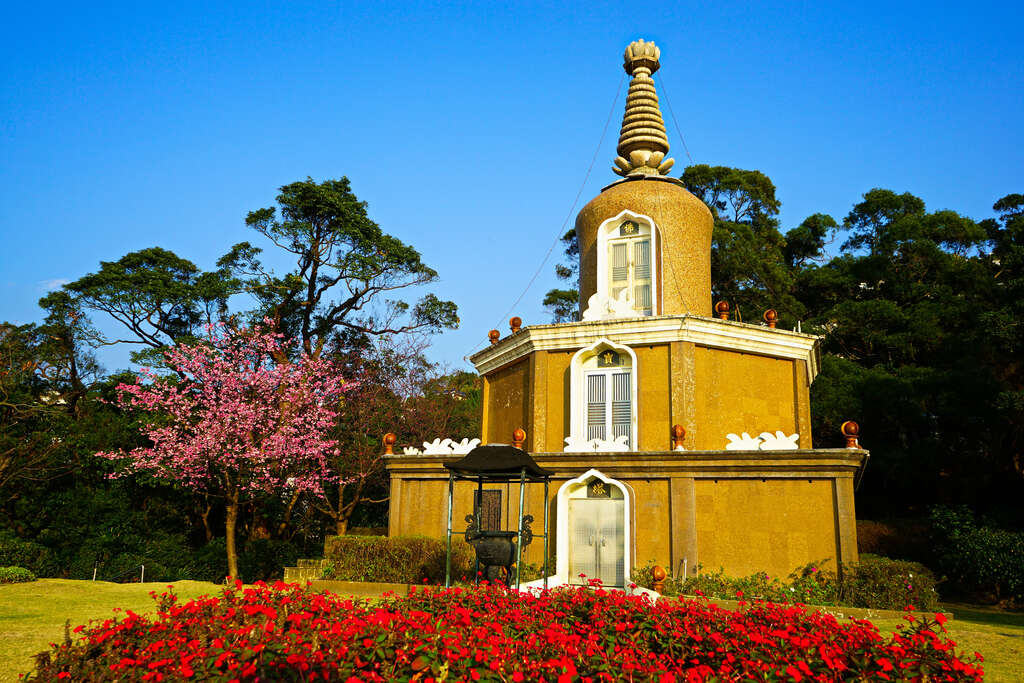Shankoji Temple Introduction
Shan Guang Temple, unlike the ornate decorations of typical temples, has a very simple exterior. Although Shan Guang Temple is not open to the public on regular days, during the cherry blossom season, visitors can still enjoy the sight of寒櫻 (Cold Cherry) and山櫻花 (Mountain Cherry) at the entrance steps, complemented by two stone lanterns, creating a unique ambiance and making it a hidden gem for cherry blossom viewing in Beitou. Beitou Shan Guang Temple is a temple of the Pure Land Buddhism's Nishiyama Shinkusa sect and was the center of faith for Japanese immigrants during that time. The temple is famous for its Buddhist relic stupa, which enshrines relics of Shakyamuni Buddha that were brought back from Japan. Beitou Shan Guang Temple originated from Shinano Shan Guang Temple in Nagano Prefecture, Japan, and was established in the 21st year of the Republic of China (1932 CE, Showa 7) by Master Shōen, the 117th abbot of the main temple, who chose the site for its foundation. In the 35th year of the Republic of China, shortly after Taiwan's retrocession, the temple's lantern continued to shine through the efforts of Master Jingxian. In the 48th year, the temple's Japanese-style hall was destroyed in the "87 Flood," and a new hall was constructed in the 51st year. In the same year, a pagoda was built to enshrine the relics of Shakyamuni Buddha, which is one of the most important features of this temple. The main deity of Shan Guang Temple is Shakyamuni Buddha, thus in the Shakyamuni Hall, the Three Jewels Buddhas (i.e., Shakyamuni Buddha, Medicine Buddha, and Amitabha Buddha) are enshrined, while in the Dharma King Hall, Amitabha Buddha is enshrined. Since the temple is a place for the monks to practice on regular days, it is not open for worship except on festival days. The most eye-catching feature of Shan Guang Temple is the stupa built in the 51st year of the Republic of China, which is modeled after Indian Buddhist temple architecture, consisting of three layers, topped with the Buddha, treasure, and pagoda, with the uppermost layer enshrining the relics of Shakyamuni Buddha from Japan; the middle and lower layers serve as spirit towers. The stupa is adorned with bronze bells and is guarded by four dragons at the middle layer, displaying great majesty, while golden lotus flowers grace the corners. In addition, Shan Guang Temple retains many relics from the Japanese era, such as the stone statue at the main gate of the Dharma King Hall and 86 stone-carved Buddha statues. Additionally, a monument named "Okamoto's Merit Tablet" stands in the temple courtyard, commemorating the discovery of the radiation-rich "Hokutolite" in the Beitou Valley by the Japanese mineral researcher Yōhachirō Okamoto in 1905. A special "Okamoto's Merit Tablet" was erected in Beitou in 1940 by Takata Fuzō. After many twists and turns over the years, it was preserved in Shan Guang Temple, serving as the best testimony to the history of Hokutolite. (Source: Hodofu Beitou - Field Research)


































